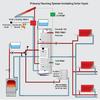There was a reply from
@ianmcd on the plumbing part, it seems
a solid fuel appliance heating HW requires a pipe Thermostat that activates a pump, and pumps the excess heat to a heat dump, usually rads but can be others
I have seen plans

showing this radiator however not seen any pump and can't see how a pump would be safe same with boiler needing a pump. These two

and

both seem to need electric to circulate the water, I remember writing to one manufacturer asking about this and never got an answer, my son with a narrow boat did use a pair of 12 volt DC pumps and a pair of pipe thermostats to switch them on one powered from domestic battery and one from engine battery so unlikely there would every be a problem powering pumps.
However with a header tank in the loft space thermo-syphon with allow the hot water to heat the header tank, and as long as the tank can take boiling water if water boils there is just a lot of noise and boiling water is ejected out of the over flow, I well remember the water spurting out onto the drive at dad's old house, by time it reached head height cool enough not to be a danger.
We can do an internet hunt for the Backer BT 18 and see it does contain a over temperature fuse or cut out, it is a common make.
However unless you can find it listed on internet, back to original question, how do you know if the fuse or cut out is fitted. These
were at one point fitted to immersion heaters, the cut out or fuse was not part of the thermostat, and there was often a button to enable reset without removing the cover. In the main these system pre-date the internet, and where alternative domestic hot water heating is available and living in a soft water area immersion heaters and their control gear can be 50 years old, as never really used.
So question remains, with a unknown thermostat without a reset button how can one be sure it has the built in cut out or fuse when used with a thermal plastic header tank? How would any electrician doing an EICR know if OK or not?
